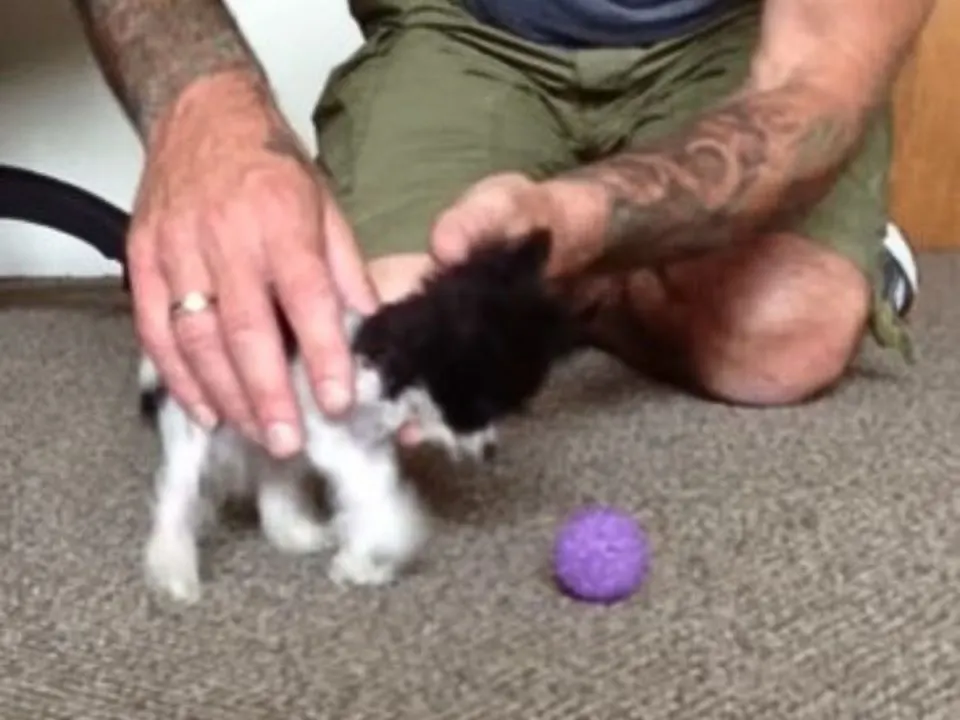Life can sometimes be very cruel, and in the very beginning, bring us to the wall. Illness, poverty, or any other adversity can render us helpless to do anything sometimes.
But, life wouldn’t be what it is if miracles didn’t happen sometimes and the most beautiful and happiest stories were written.
Today’s story is a miracle in itself and shows how immense faith and love can turn a hopeless situation around.
A Rough Beginning

When a small Poodle named Hope was born, she was just 2 pounds, while the standard weight for a newborn female Poodle is 4 to 7 lbs.
Rodney Mclean, one of the founders of K911 Animal Ambulance, was taking care of her, and was told by the veterinarians that she had dwarfism and wouldn’t live more than 48 hours.
It is either a medical or a genetic condition characterized by individuals with significantly shorter stature. When it comes to dogs, it appears in one out of a billion dogs. And, in most cases, the dog doesn’t survive.
When Rodney heard all that awful information, he was devastated at first… so much so that he was on the verge of tears.
Still, Rodney didn’t lose hope. He waited for those two days to pass to see what would happen. The best thing happened… the pup was alive. That’s when Rodney decided to call her Hope.
Of course, Rodney knew that the battle was just about to start, but he and the courageous dog were ready to become the winners.
“For the first five weeks of her life, she had to be fed,” said Rodney “That’s a tube right down to her stomach making sure she had nourishment.”
After that, he took over her care and had to get up every three hours to make sure she had enough food. It was like that every day for four full months.
Happy And Playful Against All Odds

Four hard months passed, and Hope was alive and well. She was a cheerful doggie and everything was played to her.
Although the standard weight for a Poodle is somewhere between 7 and 12 pounds, she was just 11 ounces, making her the smallest dog in the world at that moment.
Rodney said that Hope didn’t even know that she was smaller than other dogs, and her cheerful personality only confirmed that.
Aside from that, her health was great, and the vets did not notice that there could be any deterioration in the near future.
To cheer her up and make her life easier, her daddy, Rodney, would take her to his office every day and play with her. These were moments of pure happiness for Hope, which helped keep her alive despite her illness.
Unfortunately, on February 2, 2015, K911 Animal Ambulance – Ambulance Animaux K911 posted on their official Facebook page sad news. Hope crossed the rainbow bridge and she is not with us anymore.
But, we are still delighted that she lived through all those happy moments with the ones that loved her the most, and that she was a true warrior that fought against all odds.
If you’ve noticed your dog’s eye looking a bit puffy or swollen, it can be concerning. As a seasoned dog enthusiast, you understand the importance of keeping a close eye on your furry friend’s health. A swollen eye in dogs can be a sign of various underlying issues that may need attention.
Your four-legged companion relies on you to be their advocate when it comes to their well-being. Understanding the potential causes of your dog’s swollen eye is key to providing them with the care they need. Stay tuned as we explore common reasons why your dog’s eye might be swollen and how you can help them feel better.
Recognizing Swollen Eyes in Dogs
Signs and Symptoms to Watch For
Look out for signs such as redness, discharge, or squinting in your dog’s eye. Swelling around the eye area, excessive tearing, or sensitivity to light are also common symptoms. Your dog may paw at the affected eye or rub it against surfaces.
When to Seek Veterinary Care
If you notice persistent swelling, changes in behavior, or your dog seems to be in pain, it’s time to consult your veterinarian. Delaying medical attention can lead to complications, so don’t hesitate to seek professional help if you have any concerns about your dog’s swollen eye.
Common Causes of Eye Swelling in Dogs
Allergies and Environmental Irritants
If your dog’s eye is swollen, allergies to things like pollen, dust, or certain foods could be the culprit. Just like people, dogs can have allergic reactions that manifest as eye swelling. Keep an eye out for any changes in your dog’s surroundings that may trigger allergies, leading to eye swelling.
Infections and Inflammations
Eye infections or inflammations can also lead to swelling in your dog’s eye. Bacteria, viruses, or even foreign objects can cause these issues. If you notice any discharge, redness, or your dog pawing at their eye, it could indicate an infection or inflammation that needs veterinary attention.
Trauma and Accidents
Accidental injuries or trauma to the eye area can result in swelling. Whether it’s a scratch, a foreign object stuck in the eye, or a bump, these incidents can cause your dog’s eye to swell. It’s essential to be cautious when handling your dog to prevent such accidents that may lead to eye issues.
Underlying Health Conditions
Sometimes, eye swelling in dogs can be a sign of underlying health conditions such as glaucoma, corneal ulcers, or even cancer. These conditions may not always be visible externally but can impact your dog’s eye health. Regular check-ups with a veterinarian can help identify any potential health concerns early on.
Diagnostic Approach
Physical Examination
When you take your dog to the vet for a swollen eye, they’ll start with a physical exam. The vet will carefully look at the eye and surrounding area to assess the swelling, redness, discharge, and any other visible symptoms. They may also check for signs of pain or discomfort in your pup’s eye.
Tests and Procedures
To get a clearer picture of what’s causing your dog’s swollen eye, the vet may need to perform additional tests or procedures. This could include eye staining to check for injuries or ulcers, measuring the eye pressure to rule out glaucoma, or taking samples to test for infections or other underlying issues. These tests help the vet determine the best course of treatment for your furry friend.
Treatment Options for Swollen Eyes
Medications and Eye Drops
When it comes to treating swollen eyes in dogs, your vet may prescribe medications like antibiotics if there’s an underlying infection causing the swelling. Other prescription eye drops can help reduce inflammation and soothe the eye discomfort your furry friend may be experiencing. Follow your vet’s instructions carefully when administering these medications to ensure the best possible outcome for your dog’s eye health.
Home Remedies and Care
In addition to prescribed medications, there are some home remedies and care practices you can follow to help alleviate your dog’s swollen eyes. Gentle cleansers like saline solution can be used to clean any discharge around the eye area. Applying a warm compress to the affected eye can also help reduce swelling and provide some relief. Ensure your dog doesn’t scratch or further irritate the swollen eye and keep their living environment clean to prevent any potential allergens or irritants.
Surgical Interventions
In more severe cases of eye swelling where medications and home remedies may not be sufficient, surgical interventions may be necessary. Procedures such as drainage of abscesses or cysts, removal of foreign objects, or even surgery to address underlying issues like tumors may be recommended by your vet. Surgical interventions are typically reserved for situations where conservative treatments have proven ineffective, and the health and well-being of your dog require more immediate and invasive measures.
Preventing Eye Issues in Dogs
Regular Check-Ups and Vaccinations
Ensure you schedule regular check-ups with your vet to keep your dog’s overall health in check. Vaccinations are crucial in preventing conditions that could lead to eye issues. By staying up to date with vaccinations, you’re taking a proactive step in safeguarding your dog’s well-being.
Eye Care and Hygiene Tips
Maintaining proper eye care and hygiene for your dog is essential. Regularly clean around your dog’s eyes to prevent debris buildup that could cause irritation. Use a damp cloth or specialized pet wipes to gently wipe away any dirt or discharge. Remember, a clean eye area is a healthy eye area.
Protecting Your Dog’s Eyes
Protect your dog’s eyes from potential hazards by being mindful of their environment. Avoid exposing them to harmful chemicals or foreign objects that could cause injuries or infections. When outdoors, consider using dog-safe goggles or keeping long-haired breeds’ fur trimmed around the eyes to prevent irritation. Remember, prevention is key to ensuring your dog’s eyes stay healthy and happy.
Conclusion
So, there you have it – keeping an eye on your furry friend’s peepers is crucial for their overall health and well-being. By staying alert to any signs of eye swelling, you can ensure your pup gets the care they need promptly. Remember, regular vet check-ups, proper eye care, and a safe living environment are key to preventing eye issues in your dog. Stay proactive, follow your vet’s advice, and give those puppy eyes the love and attention they deserve. Your furry companion will thank you with those wagging tails and endless licks!
Frequently Asked Questions
What are the common symptoms of swollen eyes in dogs?
Swollen eyes in dogs may present with redness, discharge, squinting, or sensitivity to light. In severe cases, dogs may exhibit pawing at the eyes or excessive tearing.
What are the potential causes of swollen eyes in dogs?
Causes of swollen eyes in dogs include allergies, infections, trauma, foreign bodies, anatomical issues, or underlying health conditions like glaucoma or ulcers.
How are swollen eyes in dogs typically treated?
Treatment may involve prescribing medications like antibiotics or antihistamines, applying eye drops, or in severe cases, surgical interventions like draining abscesses or removing foreign objects.
How can dog owners prevent swollen eyes in their pets?
Preventive measures include regular veterinary check-ups, maintaining a clean living environment, monitoring environmental triggers, proper eye care, and protecting dogs from potential hazards.
[no_toc]

Hey there, I’m Janet Brooks, a dog-loving student from California. I’m all about helping pups in need, especially those without homes. Me and my awesome friends work together to give shelter and love to stray dogs. Oh, and I also write blogs about dogs to share helpful info.
